|
Submarine 101
Types of Privately Owned Subs
Scuba Tow Sled
 Not
really a submarine, but a good starting point. The sled or "dive
plane" is tied to a slow moving boat and the diver hangs on for the
ride, controlling the angle of the sled to control side to side and
depth. Obstacles, snags, and no communication with the boat would
be a problem, but they would be great for searching large areas as
long as you did not need to stop frequently. A nice add-on would be
to build in a simple electric light signal system to signal boat
operator. The advantage is the dirt cheap price and the fact that
and children could build this. Otherwise they are also available
from www.discountdivers.com
for $70. Not
really a submarine, but a good starting point. The sled or "dive
plane" is tied to a slow moving boat and the diver hangs on for the
ride, controlling the angle of the sled to control side to side and
depth. Obstacles, snags, and no communication with the boat would
be a problem, but they would be great for searching large areas as
long as you did not need to stop frequently. A nice add-on would be
to build in a simple electric light signal system to signal boat
operator. The advantage is the dirt cheap price and the fact that
and children could build this. Otherwise they are also available
from www.discountdivers.com
for $70.
Tow sleds were used to search miles of shallow, clear waters off
the shores of the Turks and Caicos Islands, looking for the wreak of
the Spanish slave ship Trouvadore bound for Cuba. In broke apart on
the reefs 1841 and all of the 193 slaves made it to shore and
freedom under the British rule of the islands. Most ended up
working salt ponds and settled on the islands, where their ancestors
live today. See:
www.slaveshiptrouvadore.com
Diver Propulsion Vehicle or DPV
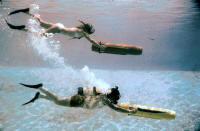 Also
not really a submarine, but getting closer. The basic scuba tows is
little more that battery powered boat trolling motors with an on/off
switch. New they cost from $260 but several Do-It-Yourself plans are
available. See www.scubatow.com Scuba tows give the divers much greater speed
and range. And because the diver is not exerting energy swimming
the available air supply will last much longer. Keep in mind that
you may need to return on your own if the battery goes dead. Cave
divers have drown when they used up their air supply trying to exit
a cavern system after their tows stopped running after having
assisted them deep into the cave. Also
not really a submarine, but getting closer. The basic scuba tows is
little more that battery powered boat trolling motors with an on/off
switch. New they cost from $260 but several Do-It-Yourself plans are
available. See www.scubatow.com Scuba tows give the divers much greater speed
and range. And because the diver is not exerting energy swimming
the available air supply will last much longer. Keep in mind that
you may need to return on your own if the battery goes dead. Cave
divers have drown when they used up their air supply trying to exit
a cavern system after their tows stopped running after having
assisted them deep into the cave.
Wet Sub
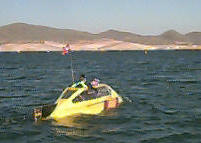 A
wet sub is the next step up from a scuba tow. A wet sub provides
added protection for the divers. More battery capacity provides
greater range than scuba tows. The occupants still breath from
scuba tanks but additional tanks are often incorporated in order to
increase the bottom time. The divers can park the sub on the bottom
and leave it with their own air tank. Another advantage is wet subs
allow the divers to transport cargo such as spear guns, metal
detectors, and catches like catfish and lobsters. The depth of wet
subs is limited to scuba diving depths or about 120 feet, and the
depth is controlled by first adjusting the amount of air in the
sub's ballast tanks, and then fine adjustment are made with the
thrusters. If the subs thrusters are at the aft the forward
momentum is needed in order before the steering is effective.
See More Photos... A
wet sub is the next step up from a scuba tow. A wet sub provides
added protection for the divers. More battery capacity provides
greater range than scuba tows. The occupants still breath from
scuba tanks but additional tanks are often incorporated in order to
increase the bottom time. The divers can park the sub on the bottom
and leave it with their own air tank. Another advantage is wet subs
allow the divers to transport cargo such as spear guns, metal
detectors, and catches like catfish and lobsters. The depth of wet
subs is limited to scuba diving depths or about 120 feet, and the
depth is controlled by first adjusting the amount of air in the
sub's ballast tanks, and then fine adjustment are made with the
thrusters. If the subs thrusters are at the aft the forward
momentum is needed in order before the steering is effective.
See More Photos...
Semi Dry Sub
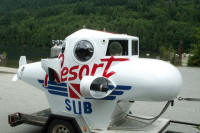 Not being completely wet has its advantages. Sitting in a semi
dry sub your out of the water from about your chest on up, about
like sitting in a hot tub. The top of the sub traps a pocket of air
that allows the occupants to breath, talk, and view thought the
windows without wearing any scuba gear. Because air is compressed
as the sub descends and because the occupants need to breath, fresh
air from scuba tanks is constantly feed into the compartment at
about 4 cubic feet per minute. The excess air simply leaks out of a
hole so the water maintains a constant depth inside the sub. Since
the top of the sub must be air tight you enter most semi dry subs,
like the Resort Sub show here, by swimming up into the cabin. The
sub simply has an opening underneath, no hatch is needed. Like wet
subs, semi dry subs maintain their depth by balancing the amount of
air in there ballast tanks against the amount of weight from lead
and batteries. It is important for semi dry subs to be maintain a
constant volume of air in order to not upset their buoyancy. The
Resort Sub shown is equipped with vertical thrusters on each side.
These allow it to maintain control of the depth without constant
adjustments to the ballast tanks. It is very important to
understand that even though the occupants are not breathing thought
a scuba regulator, they are still breathing compressed air, nitrogen
is still building up in their bodies, and a sudden accent is very
dangerous. So all of the rules an precautions for scuba divers also
apply to semi-dry sub occupants. The Resort Sub is
manufactured by International VentureCraft Corp, and they provide a
wealth of information on their web site:
www.ivccorp.com
and will be glad to sell you one for only $44,000 Not being completely wet has its advantages. Sitting in a semi
dry sub your out of the water from about your chest on up, about
like sitting in a hot tub. The top of the sub traps a pocket of air
that allows the occupants to breath, talk, and view thought the
windows without wearing any scuba gear. Because air is compressed
as the sub descends and because the occupants need to breath, fresh
air from scuba tanks is constantly feed into the compartment at
about 4 cubic feet per minute. The excess air simply leaks out of a
hole so the water maintains a constant depth inside the sub. Since
the top of the sub must be air tight you enter most semi dry subs,
like the Resort Sub show here, by swimming up into the cabin. The
sub simply has an opening underneath, no hatch is needed. Like wet
subs, semi dry subs maintain their depth by balancing the amount of
air in there ballast tanks against the amount of weight from lead
and batteries. It is important for semi dry subs to be maintain a
constant volume of air in order to not upset their buoyancy. The
Resort Sub shown is equipped with vertical thrusters on each side.
These allow it to maintain control of the depth without constant
adjustments to the ballast tanks. It is very important to
understand that even though the occupants are not breathing thought
a scuba regulator, they are still breathing compressed air, nitrogen
is still building up in their bodies, and a sudden accent is very
dangerous. So all of the rules an precautions for scuba divers also
apply to semi-dry sub occupants. The Resort Sub is
manufactured by International VentureCraft Corp, and they provide a
wealth of information on their web site:
www.ivccorp.com
and will be glad to sell you one for only $44,000
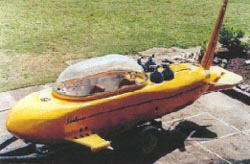 Dry
ambient subs are just a simple step up from semi-dry subs. Ambient
means that the occupants are exposed to the pressure of the
water surrounding the sub. They ride in an air bubble, and
like all air bubbles it want to rise to the surface. The
larger the amount of air then the larger the upward force.
That force is equal to the weight of the water that fill the space
where the air is. When you think about building a dry ambient
submarine, it's a lot like thinking of building an aquarium. A
100 gallon aquarium weights about 820 pounds. That's a lot of
weight pushing down on the bottom, so it must be built strong.
If you took the same 100 gallon aquarium and put it upside down in a
swimming pool then filled it with air, it would be the same.
820 pounds of water wants to fill the aquarium and push the air out,
so the air is pushing on what is normally the bottom of the aquarium
with 820 pounds of force. And your going to need 820 pounds to
hold that aquarium down. For the crew inside a dry ambient is
breathing air that is under pressure so to the crew it's still just
like scuba diving but they are are warm and dry. Herve Jaubert
designed and built a complete line of dry ambient
subs like the Explorer pictured here Dry
ambient subs are just a simple step up from semi-dry subs. Ambient
means that the occupants are exposed to the pressure of the
water surrounding the sub. They ride in an air bubble, and
like all air bubbles it want to rise to the surface. The
larger the amount of air then the larger the upward force.
That force is equal to the weight of the water that fill the space
where the air is. When you think about building a dry ambient
submarine, it's a lot like thinking of building an aquarium. A
100 gallon aquarium weights about 820 pounds. That's a lot of
weight pushing down on the bottom, so it must be built strong.
If you took the same 100 gallon aquarium and put it upside down in a
swimming pool then filled it with air, it would be the same.
820 pounds of water wants to fill the aquarium and push the air out,
so the air is pushing on what is normally the bottom of the aquarium
with 820 pounds of force. And your going to need 820 pounds to
hold that aquarium down. For the crew inside a dry ambient is
breathing air that is under pressure so to the crew it's still just
like scuba diving but they are are warm and dry. Herve Jaubert
designed and built a complete line of dry ambient
subs like the Explorer pictured here
.
Diesel Electric Dry Ambient Sub
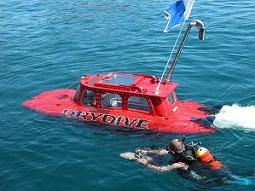 Once
there is a dry place to put an engine you can add a diesel to power
the boat when it is not completely submerged. Diesel engines
are most commonly used because there is no danger of the gasoline
vapors causing an explosion. The diesels are only good while they
can draw air from the surface, but they use so much air that it is
impractical to try an run them from air tanks, so electric motors
are still used when under water. Once
there is a dry place to put an engine you can add a diesel to power
the boat when it is not completely submerged. Diesel engines
are most commonly used because there is no danger of the gasoline
vapors causing an explosion. The diesels are only good while they
can draw air from the surface, but they use so much air that it is
impractical to try an run them from air tanks, so electric motors
are still used when under water.
My favorite dry ambient sub is DryDive. She and her builder
Brent Shaw, hail from New Zealand. Read more and see
construction photos here: Dry Ambient Sub
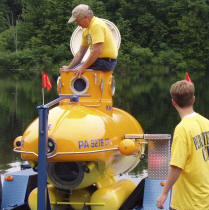 By
far the most popular choice in home submersibles is the 1 ATM or 1
Atmosphere submarine. Dan H is launching his
Kittredge; K350 pictured here. By
far the most popular choice in home submersibles is the 1 ATM or 1
Atmosphere submarine. Dan H is launching his
Kittredge; K350 pictured here.
Standing on the sea shore we are
subjected to 1 atmosphere of air pressure and once a 1 ATM sub is
closes it's hatch the pressure inside does not change even when its
dives. Typical maximum operating depths for home built 1 ATM subs is
about 350 feet. Depth is the 1 ATM subs greatest advantage,
and by adding carbon dioxide scrubbers and supplemental oxygen a 1
ATM sub can stay submerged for days. However the 1 ATM is also one
of the more complex and demanding submarine to build.
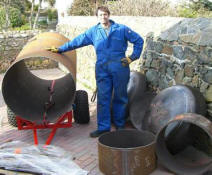 James
from Guernsey, England is shown here standing next to his hull
components. His web site;
www.guernseysubmarine.com
will quickly show the amount of work that goes into building a 1
ATM. Another good site is
John Farrington's Sub page. Both are building Kittredge designs
from plans. This is a popular choice and is discussed in detail on
the PSUBS.org forum. James
from Guernsey, England is shown here standing next to his hull
components. His web site;
www.guernseysubmarine.com
will quickly show the amount of work that goes into building a 1
ATM. Another good site is
John Farrington's Sub page. Both are building Kittredge designs
from plans. This is a popular choice and is discussed in detail on
the PSUBS.org forum.
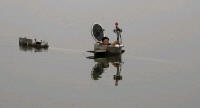 You
do not need $25,000 to build a sub. Even a 1 ATM sub.
And you do not have to be an engineer. Tao Xiangli for Begin China,
spent less that $5000. Read more here:
Tao Xiangli's Submarine You
do not need $25,000 to build a sub. Even a 1 ATM sub.
And you do not have to be an engineer. Tao Xiangli for Begin China,
spent less that $5000. Read more here:
Tao Xiangli's Submarine
Interesting Variations from the "Normal" Sub
Wood Hull, Dry Ambient, Bottom Crawler
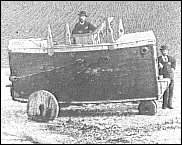 In
1894, Simon Lake needed a cheap way to demonstrate his idea for a
submarine so he built the Argonaut Junior from wood, canvas and pine
pitch. He used lead or iron for the ballast and air tanks from a soda
fountain. There was a hatch in the bottom that allow him to
retrieve items from the bottom, proving to a skeptical audience that
he had actually been on the bottom. The best part is that it
worked like a charm. So if you really want to build a sub and don't
have much budget, then follow Simon Lakes "can do" approach.
And we build and dove a recreation of Simon's Argonaut Jr. so we
know. See Argonaut Jr. 2010 In
1894, Simon Lake needed a cheap way to demonstrate his idea for a
submarine so he built the Argonaut Junior from wood, canvas and pine
pitch. He used lead or iron for the ballast and air tanks from a soda
fountain. There was a hatch in the bottom that allow him to
retrieve items from the bottom, proving to a skeptical audience that
he had actually been on the bottom. The best part is that it
worked like a charm. So if you really want to build a sub and don't
have much budget, then follow Simon Lakes "can do" approach.
And we build and dove a recreation of Simon's Argonaut Jr. so we
know. See Argonaut Jr. 2010
1 ATM Concrete Hull
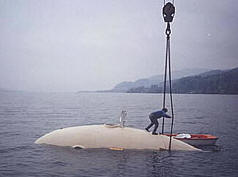
In 1994 Wilfried Ellmer built a 20 ton, 9 m long 2.5 meter
diameter concrete sub with an 18cm wall thickness in the form of a
blimp. The photo show the sub being launched into lake Atter
in Austria. Concrete is actually a great material
submarines as you need a lot of ballast for a 1 ATM hull, and the
compression force applied by water is exactly the thing that
concrete does best. So if you are in the market for a big, low
cost hull, Wilfrend will be glad to hear from you. See more at
www.concretesubmarine.com
Flying
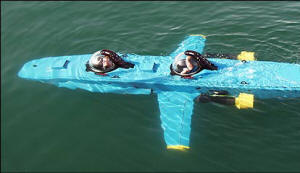
Wings, aelerons, and tails work underwater too. Deep Flight is a
commercial submarine developed by Gram Hawkes that takes advantage
of this in order to give the submarine airplane like qualities. Deep
Flight is positive buoyant and only stays underwater as long as it
stays moving. If slows down too much is stalls and rises
uncontrolled to the surface, just like like an airplane. See
more at
www.deepflight.com
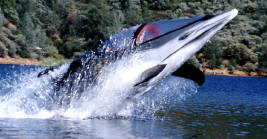
The Bionic Dolphin is another example of a flying submarine.
Power by a large air breathing engine its submerge time is measured
in seconds, but its surface performance is more that of a jet ski.
See more at:
www.bionicdolphin.com
Surface Planing
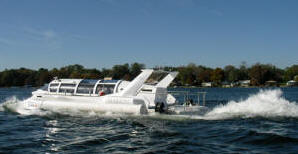 Planing
is a trait know to speed boats and not submarines. A boat is
on plane when the hull lifts from the water enough to ride over its
bow wave. The heaver a boat is, the more horse power it will
require to get it to plane. Submarines are notoriously heavy
because of the ballast weight required in order to get drop beneath
the surface, so getting a 1 ATM submarine to plan is a remarkable
achievement. The Hyper-Sub, pictured here is built by Reynolds
Marion and the first 1 ATM to achieve a plan using a staggering
880HP to do so. See more at
www.hyper-sub.com. Planing
is a trait know to speed boats and not submarines. A boat is
on plane when the hull lifts from the water enough to ride over its
bow wave. The heaver a boat is, the more horse power it will
require to get it to plane. Submarines are notoriously heavy
because of the ballast weight required in order to get drop beneath
the surface, so getting a 1 ATM submarine to plan is a remarkable
achievement. The Hyper-Sub, pictured here is built by Reynolds
Marion and the first 1 ATM to achieve a plan using a staggering
880HP to do so. See more at
www.hyper-sub.com.
The Navy SEALS are the ideal candidates for a go-fast small
submarine, and they have a diesel powered SPWS (surface planing wet
sub) built for them by
STIDD Systems. A
wet sub does not have the ballast weight of a 1 ATM so the the
available HP translates into more speed and range. The SPWS
design criteria called for the ability to carry a six-man team
and 1,830 pounds of gear up to 165 nautical miles away on the
surface or 18 nautical miles under the surface. Surface speed is to be around 30
knots and submerged speeds are thought to be around 6 knots.
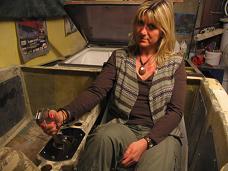 If
your interest is in a garage build Surface Planing Wet Sub then you
want a to follow Franck Iapichino's progress as he builds his wet
sub out of a fiberglass speed boat hull. He has added a water tight
compartment for an 80hp yamaha jet-ski engine that will propel the
boat on the surface. Franck's lovely wife Loetitia demonstrates the
helm. See more... If
your interest is in a garage build Surface Planing Wet Sub then you
want a to follow Franck Iapichino's progress as he builds his wet
sub out of a fiberglass speed boat hull. He has added a water tight
compartment for an 80hp yamaha jet-ski engine that will propel the
boat on the surface. Franck's lovely wife Loetitia demonstrates the
helm. See more...
Dry Ambient Submarine Yacht

At $8 million a submarine can be just another ostentatious
display but Proteus created by Herve Jaubert of Exomos is also an
example of creative engineering. "Displacement 45 tons, carries 10 people in the watertight cabin
and up to 15 divers on deck. 1200HP diesel engine for surface and
200 kw electric motor for submerged transits. 300 miles range
surface, 24 miles range under the water. Manned with 1 pilot and 1
engineer
Top speed 25 knts price tag: $8M" --Herve Jaubert
See more photos...
|